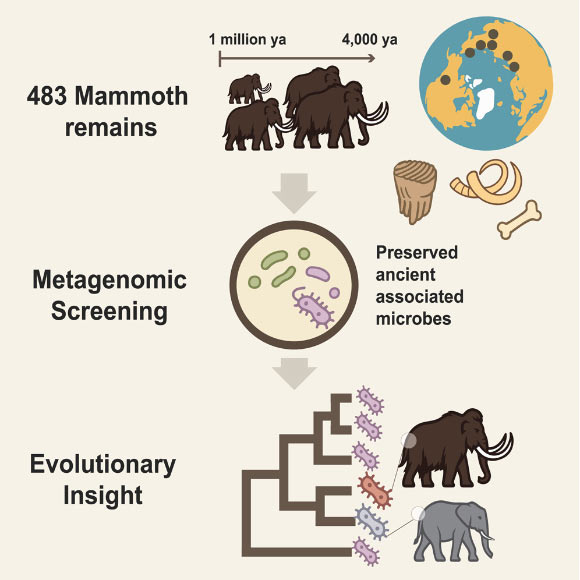In a new study, scientists analyzed ancient microbial DNA from 483 mammoth remains spanning over 1 million years, including 440 newly-sequenced and unpublished samples from a 1.1-million-year-old steppe mammoth. Using metagenomic screening, contaminant filtering, damage pattern analysis, and phylogenetic inference, they identified 310 microbes associated with different mammoth tissues.

Guinet et al. reconstructed partial genomes of Erysipelothrix from the oldest mammoth sample, representing the oldest authenticated host-associated microbial DNA to date. Image credit: Guinet et al., doi: 10.1016/j.cell.2025.08.003.
“Imagine holding a million-year-old mammoth tooth,” said Dr. Benjamin Guinet, a postdoctoral researcher at the Centre for Palaeogenetics in Stockholm and the Swedish Museum of Natural History.
“What if I told you it still carries traces of the ancient microbes that lived together with this mammoth?”
“Our results push the study of microbial DNA back beyond a million years, opening up new possibilities to explore how host-associated microbes evolved in parallel with their hosts.”
The researchers identified six microbial groups consistently associated with mammoth hosts, including relatives of Actinobacillus, Pasteurella, Streptococcus, and Erysipelothrix. Some of these microbes may have been pathogenic.
For instance, one Pasteurella-related bacterium identified in the study is closely related to a pathogen that has caused fatal outbreaks in African elephants.
Since African and Asian elephants are the closest living relatives of mammoths, these findings raise questions about whether mammoths may also have been vulnerable to similar infections.
Remarkably, the scientists reconstructed partial genomes of Erysipelothrix from a 1.1-million-year-old steppe mammoth, representing the oldest known host-associated microbial DNA ever recovered.
This pushes the limits of what researchers can learn about the interactions between ancient hosts and their microbiomes.
“As microbes evolve fast, obtaining reliable DNA data across more than a million years was like following a trail that kept rewriting itself,” said Dr. Tom van der Valk, also from the Centre for Palaeogenetics in Stockholm and the Swedish Museum of Natural History.
“Our findings show that ancient remains can preserve biological insights far beyond the host genome, offering us perspectives on how microbes influenced adaptation, disease, and extinction in Pleistocene ecosystems.”
Although the exact impact of the identified microbes on mammoth health is difficult to determine due to DNA degradation and limited comparative data, the study provides an unprecedented glimpse into the microbiomes of extinct megafauna.
The results suggest that some microbial lineages coexisted with mammoths for hundreds of thousands of years, spanning both wide geographic ranges and evolutionary timescales, from over one million years ago to the extinction of woolly mammoths on Wrangel Island about 4,000 years ago.
“This work opens a new chapter in understanding the biology of extinct species,” said Professor Love Dalén, a researcher at the Centre for Palaeogenetics in Stockholm, the Swedish Museum of Natural History and Stockholm University.
“Not only can we study the genomes of mammoths themselves, but we can now begin to explore the microbial communities that lived inside them.”
The study was published this week in the journal Cell.
_____
Benjamin Guinet et al. Ancient host-associated microbes obtained from mammoth remains. Cell, published online September 2, 2025; doi: 10.1016/j.cell.2025.08.003







